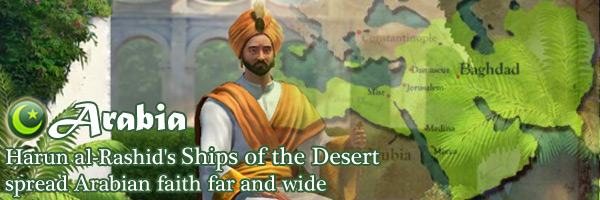
Continuing my series of strategy posts about Brave New World's modified civilizations, I'm going to take a look at strategies for Arabia. Arabia received a modest revision in Brave New World out of the box, having its national trait moderately redesigned. The old city connection economic focus has been regeared towards Brave New World's new trade route mechanic, and a religious buff was also added to make this civ more compelling for Gods & Kings mechanics.
The majority of the Arabian peninsula is harsh desert, and so massive human settlement did not begin until the rise of the Islamic empires of the middle ages. In the early seventh century, the Prophet Muhammad began preaching the tenets of Islam in Mecca and Medina, which united several Arabian tribes and led to the establishment of the Caliphate, an Islamic empire that began to extend its influence across the peninsula and beyond. In the mid seventh century, the Caliphate began conquering territory from the Byzantine empire and they completely destroyed the once-powerful Persian empire that had dominated the region since antiquity. At its height, the Caliphate extended from Portugal, Spain, and Morocco in the west, all the way to the borders of India in the east. Arabia's position as a crossroads between west and east made it a center for powerful trading hubs, and Arabian engineers and scientists developed advanced new mathematical concepts. Goods, knowledge, and religious beliefs from both ends of the known world (and beyond) often passed through Arabian trading bazaars, and much of the knowledge of the classical Greeks and Romans were preserved by Islamic scholars, eventually contributing to the European Renaissance centuries later.

Harun al-Rashid ruled during the mid eighth century during the Caliphate's golden age. He has been strongly romanticized by Arabian authors and scholars, and has even been mythologized in tales included in the Book of One Thousand and One Nights. He was known as a sharp political, intellectual, and military mind, but it is difficult to separate factual accounts from fictitious ones. Even his exact birth date is debatable. He was Caliph during one of the greatest periods of expansion of the early caliphates, but he also almost destroyed the Caliphate by dividing the empire among his sons instead of naming a single heir. This led to prolonged civil war between the sons, but the Caliphate did survive the turmoil.
[More]
91119a55-7a39-4ebe-9d91-07545ab26c34|3|5.0
Tags:Sid Meier's Civilization, Civilization V: Brave New World, Civilization V, ranged mounted unit, bazaar, Arabia, Harun al-Rashid, Ships of the Desert, Camel Archer, luxury resource, trade, trade route, caravan, cargo ship, religion, religious pressure, Religious Texts, Grand Temple, Market, Knight, Indonesia, oil, oasis, Civ-V
UPDATE (September 9, 2014, 2:45 PM Pacific Time)
Shortly after publishing this blog, I came across a forum post that contradicts the information presented in this blog post. As such, I will review the actual source code in the Civilization V dll, do some more testing with the game, and revise the post as necessary. In the meantime, I'll leave the unaltered post here, for posterity. I apologize for the inconvenience.
A lot of buildings in Civilization V mention that they are affected by tiles or resources "near the city", but this quality of being "near a city" is poorly-defined within the game. So what exactly does it mean? I haven't seen any in-depth articles about this topic on the web or in the game's Civilopedia, so I thought I'd outline the important bits here.
Basically, a tile is "near" a city if that city was the first city in its respective empire to claim that tile within its workable radius.
So if you have a single tile or resource that lies between two cities, and both cities' workable ranges overlap that same tile, then that tile is not "near" both cities. It is only "near" the first city that owned that tile. This means that if you go into the city management screen and assign the second city to work that tile, it may receive yield bonuses associated with any improvements or buildings that affect it (such as the stable buffing pasture resources), but the tile's contents will not be considered "near" that second city for other purposes. This includes:
- requirement of an improved Horse or Ivory to build a Circus,
- requirement of an improved Horse, Cow, or Sheep to build a Stable,
- requirement of an improved Iron to build a Forge,
- requirement of an improved Stone or Marble to build a Stone Works,
- requirement of an improved Gold or Silver to build a Mint,
- wonder production bonus from nearby Marble,
- requirement that the city be adjacent to a Mountain in order to build an Observatory,
- trade route income from resource diversity,
- and so on...
Say you have two cities (for example Rome and Antium) whose workable ranges overlap a pastured Horse. Rome was the first city to claim the Horse tile. Rome can, therefore, build a Circus (assuming Trapping has been researched). If you go to the management screen of Antium, you can assign it to work the Horse tile (which prevents Rome from being able to work that tile), but Antium still cannot build a Circus. That is, two cities cannot build a building that requires they both have the same tile.
[LEFT] Rome has annexed a tile containing horses and is building a Circus.
[RIGHT] Later, that tile overlaps with Antium's workable radius, but it cannot build a Circus because the horse was originally claimed by Rome.
Alternatively, if a resource is claimed by a city's culture, but is outside of a city's workable radius (four tiles or more away), then it never counts as "near" that city... [More]
c178571d-236f-4930-b087-5ba4b365ee97|0|.0
Tags:Sid Meier's Civilization, Civilization V, Civilization, Civilization V: Gods & Kings, Civilization V: Brave New World, Civilization: Beyond Earth, building, near, resource, luxury, resource diversity, Arabia, bazaar, Poland, Portugal, mare clausum, trade route, circus, stable, forge, stone works, mint, city borders, owned tiles, Ducal Stable, Civilization V
|

| 12 | | | | | | | 60 | | 11 | | | | | | | 55 | | 10 | | | | | | | 50 | | 09 | | | | | | | 45 | | 08 | | | | | | | 40 | | 07 | | | | | | | 35 | | 06 | | | | | | | 30 | | 05 | | | | | | | 25 | | 04 | | | | | | | 20 | | 03 | | | | | | | 15 | | 02 | | | | | | | 10 | | 01 | | | | | | | 05 |
|